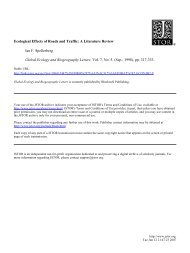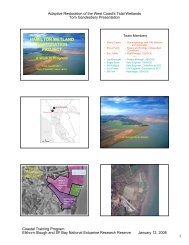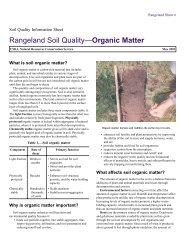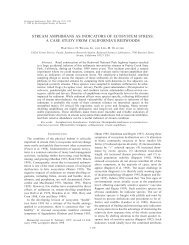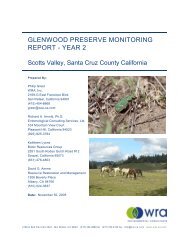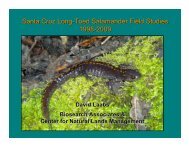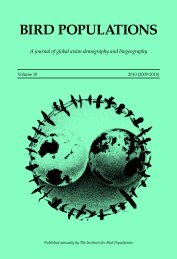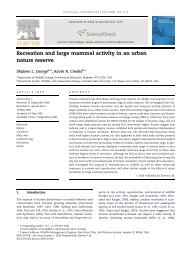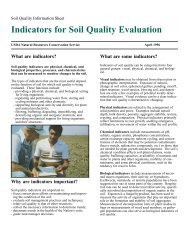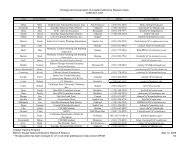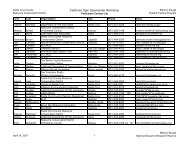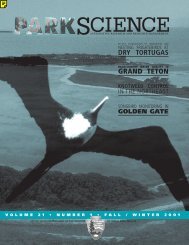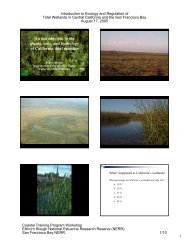Can Carbon Addition Increase Competitiveness of Native Grasses ...
Can Carbon Addition Increase Competitiveness of Native Grasses ...
Can Carbon Addition Increase Competitiveness of Native Grasses ...
Create successful ePaper yourself
Turn your PDF publications into a flip-book with our unique Google optimized e-Paper software.
Sawdust <strong>Addition</strong> and <strong>Native</strong> Grass <strong>Competitiveness</strong>Table 1. Amendments <strong>of</strong> labile carbon (C) to reduce plant-available nitrogen and increase competitiveness <strong>of</strong> slower growing species.Study C Source Quantity and Form Study Duration (years)This study 1.2 sawdust 2Blumenthal et al. (2003) Various quantities <strong>of</strong> sucrose and sawdust 2Cione et al. (2002) 2.5 cm depth leaf and bark mulch 1Alpert & Maron (2000) 1.5 sawdust 2Paschke et al. (2000) 1.1 sucrose 3Torok et al. (2000) 0.1 sucrose 1 0.03 kg/m 2 sawdust 1Reever Morghan & Seastedt (1999) 1.0 sucrose 1 0.7 kg/m 2 sawdust 1Hopkins (1998) 24 g C/m 2 as sucrose and sawdust 3Zink & Allen (1998) 3 cm depth pine bark, oat straw 3Wilson & Gerry (1995) 0.4 sawdust 1McLendon & Redente (1992) 1.1 sucrose 3Quantity is kilogram <strong>of</strong> sawdust or sucrose per square meter added through the entire experiment. Frequency and method <strong>of</strong> application varied among studies.reported that exotic biomass decreased and native biomassincreased when a mixture <strong>of</strong> sucrose and sawdust wasadded to a tallgrass prairie restoration site. Sawdustremains an enticing tool for native restoration because <strong>of</strong>its ease <strong>of</strong> application and its cost effectiveness relative tosucrose. But if it decreases the production <strong>of</strong> all vegetation(natives and exotics), as has been reported in a number <strong>of</strong>studies, then sawdust would be less useful as a restorationtool than it would be if native biomass or competitivenessincreases.We tested the ability <strong>of</strong> sawdust addition to benefit nativeperennial grass species in competition with two differenttypes <strong>of</strong> exotic grasses—exotic annual and exotic perennialgrasses—in an ecosystem that had undergone N enrichment.We hypothesized that sawdust addition would lessen thecompetitive impact <strong>of</strong> exotic species on native species duringthe establishment phase. We expected that the impact <strong>of</strong>sawdust addition would be the strongest on native perennial,exotic annual interactions, because exotic annuals are knownto be particularly responsive to changes in nutrient availability(Huenneke et al. 1990; Maron & Connors 1996) Wechose an experimental design that permitted the examination<strong>of</strong> the relative impacts <strong>of</strong> native and exotic grasses oneach other with and without sawdust addition. This representsa more complete test <strong>of</strong> the mechanisms <strong>of</strong> the benefitsto native species <strong>of</strong> sawdust addition than previous studies.We further hypothesized that the effect <strong>of</strong> sawdust additionon native species in the absence <strong>of</strong> exotic competitors wouldbe negative, indicating that the benefits <strong>of</strong> C addition tonatives are mediated by the reduction in competitiveness <strong>of</strong>exotic species rather than by a direct positive effect <strong>of</strong> sawdustaddition on growth <strong>of</strong> natives.MethodsStudy AreaThis study took place at Tom’s Point, a private naturepreserve adjacent to Tomales Bay in Marin County, CA,U.S.A. (38 13 0 N, 122 57 0 W). Tomales Bay experienceshighly seasonal rainfall patterns typical <strong>of</strong> Mediterraneanclimates. Annual rainfall is 790 mm per year, mainly fallingbetween November and April. Peak growth for annuals isgenerally in late February through the end <strong>of</strong> March. Forperennial species peak growth extends longer into thespring. Rainfall patterns vary among years, although typicallythe first rainfall events that stimulate germinationoccur in late October or November and the last eventsbefore the summer drought occur in April. Mean monthlytemperature ranges from 13.9 C in March to 18.1 CinSeptember. The soil at the study site was a Tomales Seriessandy loam (fine, mixed, and mesic Ultic Paleustalf).The site has not been grazed by livestock for at least 30years. A portion <strong>of</strong> the reserve has been periodically dominatedby Lupinus arboreus (bush lupine), a short-livednative N-fixing shrub that invades coastal grassland systemsthroughout central and northern California. Atnearby Bodega Marine Reserve (BMR) L. arboreus hasbeen shown to reduce native plant diversity through Nenrichment <strong>of</strong> formerly native-dominated ecosystems(Maron & Connors 1996; Maron & Jefferies 1999). Aportion <strong>of</strong> Tom’s Point Preserve, where we establishedour experimental treatments, has become depleted <strong>of</strong>native species during repeated cycles <strong>of</strong> L. arboreus expansionand dieback. The high N content and low C : N ratio <strong>of</strong>the soils at our site (Table 2) is consistent with the patternafter L. arboreus colonization described by Maron andcolleagues (Maron & Connors 1996; Maron & Jefferies1999) at BMR. Few L. arboreus individuals were presentat the beginning <strong>of</strong> the experiment due to widespreadinsect-driven dieback (Strong et al. 1995; Maron 1998),Table 2. Mean (±SE) total nitrogen (N)and total carbon (C), and texture<strong>of</strong> the soil (top 10 cm) at the study site before the experiment.Total soil N (mg N/g dry mass soil)* 4.1 (0.1)Total soil C (mg C/g dry mass soil)* 49.5 (1.6)C : N ratio 12.1 (0.05)Sand (%) 83Silt (%) 13Clay (%) 5*Carlo-Erba CHN autoanalyzer (Fisions Instruments, Milan, Italy).MARCH 2004 Restoration Ecology 37
Sawdust <strong>Addition</strong> and <strong>Native</strong> Grass <strong>Competitiveness</strong>and the area was dominated by introduced annual grassesincluding Avena barbata (slender wild oat), Bromusdiandrus (ripgut brome), and Vulpia myuros (zorro fescue),introduced perennial grasses including Festuca arundinacea(tall fescue), Holcus lanatus (velvet grass), andPhalaris aquatica (harding grass) and such exotic annualand biennial forbs as Carduus pycnocephala (Italian thistle)and Conium maculatum (poison hemlock).Experimental DesignSeeds <strong>of</strong> the introduced annual grasses A. barbata,B. diandrus, andV. myuros, the introduced perennial grassesF. arundinacea, H. lanatus, and P. aquatica, and the nativeperennial grasses Agrostis idahoensis (bent grass), Festucarubra (red fescue), and Nassella pulchra (purple needlegrass)were collected by hand at Tom’s Point Preserve inSpring 1998. Seeds <strong>of</strong> the introduced and native perennialgrasses were planted in individual Conetainers (Stueweand Sons, Corvallis, OR, U.S.A.) in September 1998 andallowed to germinate under greenhouse conditions.In summer 1998, standing C. pycnocephala and C. maculatumindividuals at Tom’s Point Preserve were cut atground level and removed. All remaining vegetation wassprayed with 5–10% glyphosate-based herbicide andremoved, leaving bare soil. We established 70 1.5 3 1.5–mplots (with a 1–2 m buffer between plots) and assignedeach plot to one <strong>of</strong> five treatments (Table 3). Because <strong>of</strong>the differences in size and longevity between exotic annualand exotic perennial grasses, it was not possible to equatethe competitive environment experienced by native perennialgrasses growing with each exotic group. Thereforewe chose two different experimental designs to test theinteractions between the native perennials and the exotics.We used an additive design in the case <strong>of</strong> the exoticannuals, whereby the density <strong>of</strong> individuals in plots containingboth native perennials and exotic annuals was thesum <strong>of</strong> the number <strong>of</strong> individuals in single-group plots. Incontrast, we used a replacement design in the case <strong>of</strong> theexotic perennials, whereby the density <strong>of</strong> individuals ineach treatment remained constant (Table 3).Annual seed densities applied in fall 1998 (Table 3) werechosen to fall within the range reported by Heady (1956)for Californian annual grasslands. Annual grass seeds wereapplied to appropriate plots in fall 1999 (second year) bothby allowing established plants from the previous growingseason to set seed and by supplementing this natural seedrain with seed collected outside the experimental plots.Seeds were added at the same level as the previousseason, with the exception that the number <strong>of</strong> Vulpiaseeds was reduced to 7,750 seeds/plot. Perennial seedlingswere transplanted from Conetainers between 5 and 14January 1999 using a 2.5-mm soil corer to dig holes. Seedlingswere planted in a 12 3 12 grid totaling 144 individualsper plot (Corbin & D’Antonio in press). Each plantwas separated from its neighbors by 12 cm. The location<strong>of</strong> the species neighborhoods within each plot’s grid wasdetermined by randomly selecting grid location so thateach species had the same number <strong>of</strong> individuals perplot. Plots were weeded <strong>of</strong> dicots and non-target grassesthree times each year to maintain species composition anddensity.We randomly selected six <strong>of</strong> the 14 plots to receivesawdust amendments, leaving eight plots that did notreceive sawdust amendments. All plots were raked (top2–4 cm) between 7 and 12 December 1998. We expectedthat frequent applications <strong>of</strong> sawdust would be more effectivethan a single large dose in influencing soil N cycling(Alpert & Maron 2000). Sawdust additions <strong>of</strong> 200 g/m 2were repeated in February (immediately before peak vegetationgrowth) and April 1999. <strong>Addition</strong>s in the 1999–2000growing season were performed in November 1999 (1week after the first significant rains <strong>of</strong> the season), March2000, and April 2000 at similar rates as in the previousgrowing season. All sawdust additions after the December1998 application were cast onto the soil surface, ratherthan raked, so as to minimize the disturbance <strong>of</strong> the vegetationand soil matrix. The sawdust in the first season was ahardwood mixture obtained from a local lumber supplycenter; the following season the sawdust was obtainedat a furniture-making store that used only maple wood(Acer sp.). Sawdust from both sources was finely texturedand was observed to become well mixed into the top 10 cm<strong>of</strong> the soil during the experiment, though this effect wasnot quantified.Plant GrowthAboveground biomass <strong>of</strong> annual grasses was destructivelysampled at peak biomass in Spring 1999 and 2000. AllTable 3. Treatments and initial planting densities (seeds or seedlings/2.25 m 2 ).Treatment Avena Seeds Bromus Seeds Vulpia Seeds <strong>Native</strong> Perennial Seedlings Exotic Perennial SeedlingsAnnual only 3,400 1,750 9,000 0 0<strong>Native</strong> perennial 0 0 0 144 0Exotic perennial 0 0 0 0 144Annual and native perennial 3,400 1,750 9,000 144 0Exotic perennial and native perennial 0 0 0 72 72Exotic annual seed densities were chosen to fall within the range reported by Heady (1956) for California grasslands.38 Restoration Ecology MARCH 2004
Sawdust <strong>Addition</strong> and <strong>Native</strong> Grass <strong>Competitiveness</strong>76No sawdust+ Sawdust5Ammonium concentration(µg NH 4/g soil)54321Nitrate concentration(µg NO 3/g soil)43211.52.0Net N mineralization rate(µg N/g soil/day)1.00.50.0Net nitrification rate(µg N/g soil/day)1.51.00.50.0–0.5–0.5Feb 1999Jun 1999Oct 1999Feb 2000Jun 2000Feb 1999Jun 1999Oct 1999Feb 2000Jun 2000Figure 1. Extractable ammonium and nitrate concentrations, net nitrogen (N) mineralization rate, and net nitrification rate in unamended andsawdust-amended plots. Points represent mean ± 1 SE.from the repeated measures ANOVA, the effect <strong>of</strong> sawduston net N mineralization and net nitrification was notsignificant.Microbial biomass N was significantly higher in sawdustamendedplots than non-sawdust plots in November 1999(0.080 ± 0.003 versus 0.031 ± 0.003 mg N/g soil [mean ± SE]and April 2000 (0.095 ± 0.005 versus 0.041 ± 0.004 mg N/gsoil) (repeated measures ANOVA: F [1,58] 5 10.09, p < 0.01).GWC was not significantly different in sawdust-amendedplots as compared with non-sawdust-amended plots(repeated measures ANOVA: F [1,58] 5 1.86, p > 0.15).Plant Responses to Sawdust <strong>Addition</strong>The aboveground growth in the first growing season <strong>of</strong> allthe three native species was negatively affected by competitionwith exotic annual species (Table 4; Fig. 2a). Theeffect <strong>of</strong> sawdust on one <strong>of</strong> the native species, Nassellapulchra, in that year was dependent on the presence orabsence <strong>of</strong> annual species. When grown in the absence <strong>of</strong>annual competitors, sawdust had a negative effect onN. pulchra. When annuals were present, N. pulchra growthwas greater with sawdust addition than without (annuals–sawdust interaction) (Table 4). Growth <strong>of</strong> one other nativespecies, Festuca rubra, showed a trend toward the samepattern (Table 4). Competition with annual speciesreduced growth <strong>of</strong> Agrostis oregonensis and F. rubra inthe second growing season (Fig. 2b), but any advantagethat sawdust may have provided for species competingwith exotic annual species was no longer detectable:ANOVA revealed no significant interactions between sawdustand competition with annual grasses (Table 4).Furthermore none <strong>of</strong> the native species’ aboveground biomassat the end <strong>of</strong> the 2-year experiment was significantlydifferent between sawdust-amended plots and plots thatdid not receive sawdust (p > 0.1).Competition with exotic perennials reduced the growth<strong>of</strong> all three native species in 1999, but there was no significanteffect <strong>of</strong> exotic perennials on native growth in thesecond growing season (Table 4; Fig. 2). There was also nosignificant interaction between exotic perennial competitionand sawdust for any <strong>of</strong> the native species in eitherseason.Among the exotic annual grasses, only Vulpia myuroswas slightly affected by competition with native grasses inthe first growing season, when its aboveground biomasswas significantly lower with competition from native species(Fig. 3a). In contrast native species decreased annualgrass production in the second season by over 50%, withall species showing significant declines (Fig. 3b). Inneither season did sawdust addition influence the production<strong>of</strong> the three annual species or the total annual grassproduction.The presence <strong>of</strong> native species did not reduce thegrowth <strong>of</strong> exotic perennial grasses in either year. In fact,Festuca arundinacea appeared to grow better with native40 Restoration Ecology MARCH 2004
Sawdust <strong>Addition</strong> and <strong>Native</strong> Grass <strong>Competitiveness</strong>Growth per plant (g)March–July 1999Growth per plant (g)October 1999–July 20002015105020151050abExotic perrenial only, no SawExotic perrenial only, + Saw+ natives, no saw+ natives, +sawHolcusHolcusp Nat = 0.04Festuca arundinaceaFestuca arundinaceaPhalarisPhalarisFigure 4. Growth <strong>of</strong> each exotic perennial grass in 1999 (a) and 2000 (b).Competition treatments: exotic perennials only and exotic perennials withnative perennial grasses. Bars represent mean ± 1 SE. Significant p valuesfrom ANOVA (model: biomass 5 block 1 native competition(Nat) 1 sawdust (Saw) 1 Nat 3 Saw) for each species are indicated.perennial grasses than with other exotic perennial grassesin 1999 (Fig. 4). Growth <strong>of</strong> exotic perennials was notaffected by sawdust addition in either growing season.DiscussionIn the first year, when natives were grown with exoticannual competitors, growth <strong>of</strong> N. pulchra and, to a lesserextent, F. rubra was greater in plots that received sawdustaddition than in plots that did not receive sawdust addition.These results were consistent with our prediction thatsawdust addition would benefit native species, particularlythose competing with exotic annual grasses. In the secondyear, however, we did not find evidence that sawdustaddition increased the competitiveness <strong>of</strong> natives. Instead,native species substantially reduced annual grass productionregardless <strong>of</strong> whether sawdust was added or not.Sawdust addition did not influence the growth <strong>of</strong> nativespecies competing with exotic perennial grasses in eithergrowing season. At the end <strong>of</strong> the experiment the abovegroundbiomass <strong>of</strong> native species receiving sawdust additionwas not greater than the biomass <strong>of</strong> natives that didnot receive sawdust. We conclude therefore that the addition<strong>of</strong> sawdust as a tool in the restoration <strong>of</strong> native speciesin our system, where target individuals were planted asseedlings and survival was high in all treatments, providedno significant benefit to natives over a 2-year period.By the second growing season, sawdust additions hadstimulated microbial immobilization <strong>of</strong> N, consistent withthe findings <strong>of</strong> Torok et al. (2000), and had reduced rates<strong>of</strong> net N mineralization. We did not find evidence thatsawdust addition decreased N availability or N cyclingrates in the first growing season. <strong>Addition</strong> <strong>of</strong> sucrose and/or sawdust has frequently been shown to reduce soil inorganicN levels in other systems (Zink & Allen 1998;Reever Morghan & Seastedt 1999; Blumenthal et al.2003), though the efficacy <strong>of</strong> sawdust and sucrose may bedependent on initial soil fertility, quantity <strong>of</strong> C added, andthe form <strong>of</strong> C added (e.g., sucrose versus sawdust)(Blumenthal et al. 2003). It is possible that the N enrichmentfrom dying lupines in our coastal prairie site(Table 2) was high enough that the rate <strong>of</strong> sawdust additionwas not sufficient to induce N limitation until thesecond year.We did not find support for the expected mechanism bywhich lower N would impact native vegetation, namely byreducing competitors’ production and indirectly benefitingnatives’ growth. Aboveground production <strong>of</strong> exotic annualor exotic perennial grasses was not affected by sawdust ineither season and hence it is difficult to explain the impact<strong>of</strong> sawdust on natives competing with annual species in thefirst growing season. The effect <strong>of</strong> sawdust on one <strong>of</strong> thenatives, N. pulchra, growing without exotic competitorswas negative, but otherwise there was no evidence thatsawdust negatively affected native growth. The possibilityremains that shifting allocation to above- versus belowgroundstructures may have masked significant differencesin the productivity <strong>of</strong> exotic annuals or exotic perennialspecies between plots receiving sawdust and plots that didnot. It is, however, unlikely that sawdust addition had adirect facilitative effect on native growth, because sawdustaddition did not increase the growth <strong>of</strong> natives in treatmentswithout competitors.Sucrose and sawdust addition to other systems has producedmore lasting benefits to native species than wefound. Paschke et al. (2000) and McLendon & Redente(1992) found that sucrose addition to two successionalshortgrass steppe ecosystems favored slower growing perennialspecies over faster growing annual grasses such asBromus tectorum (cheatgrass) and annual forbs. Howeversucrose is expensive relative to other C sources such assawdust and therefore is less practical as a restoration tool(Reever Morghan & Seastedt 1999). Zink & Allen (1998)reported improved growth and survival <strong>of</strong> hand-plantedArtemisia californica (California sagebrush) seedlingsafter 2 years <strong>of</strong> pine bark and oat straw addition to aCalifornia coastal sage scrub habitat. Sawdust addition(with or without sucrose addition) has been shown tonegatively affect exotic competitors but has been less successfulin benefiting native species (Wilson & Gerry 1995;Reever Morghan & Seastedt 1999; Alpert & Maron 2000;42 Restoration Ecology MARCH 2004



